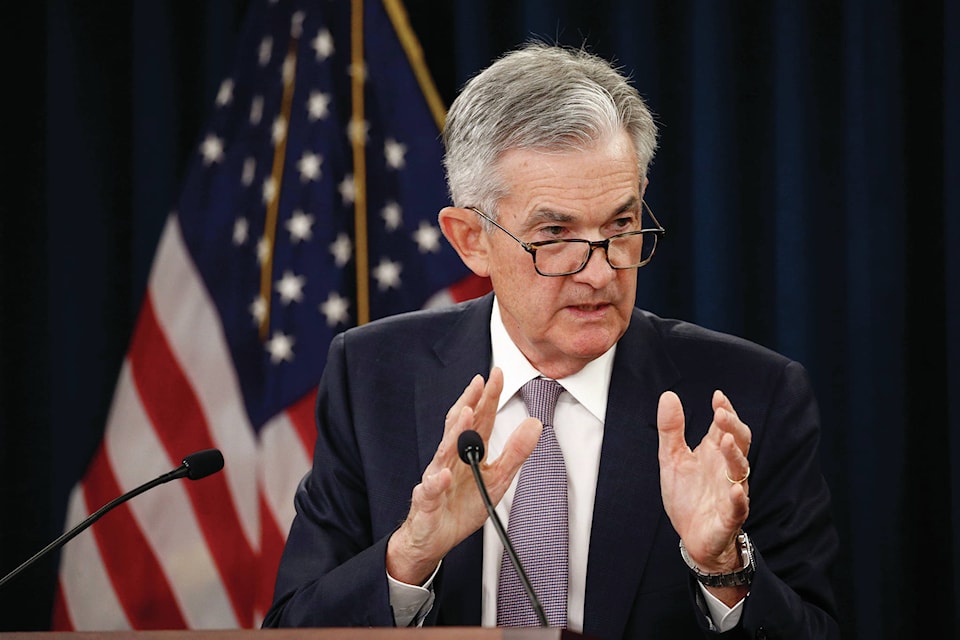WASHINGTON — A sharply divided Federal Reserve cut its benchmark interest rate Wednesday for a second time this year but declined to signal that further rate cuts are likely this year.
The Fed’s move reduced its key short-term rate — which influences many consumer and business loans — by an additional quarter-point to a range of 1.75% to 2%.
The action was approved 7-3, with two officials preferring to keep rates unchanged and one arguing for a bigger half-point cut. The divisions on the policy committee underscored the challenges for Chairman Jerome Powell in guiding the Fed at a time of high economic uncertainty.
The Fed did leave the door open to additional rate cuts — if, as Powell suggested at a news conference, the economy weakens. For now, he suggested, the economic expansion appears durable in its 11th year, with a still-solid job market and steady consumer spending.
At the same time, the Fed is trying to combat threats including uncertainties caused by President Donald Trump’s trade war with China, slower global growth and a slump in American manufacturing. The Fed noted in its statement that business investment and exports have weakened.
At his news conference, Powell acknowledged that Fed officials are sharply divided about the wisest course for interest rates, especially given uncertainties, like trade conflicts, whose outcomes are out of the Fed’s control.
“This is a time of difficult judgments and disparate perspectives,” the chairman said.
In any case, many business leaders are skeptical that the Fed’s slight rate cuts will deliver much economic benefit.
Wednesday’s rate cut “makes virtually no difference to the U.S. economy in and of itself,” said Jamie Dimon, CEO of JPMorgan Chase, who suggested, as many corporate leaders have, that Trump’s trade war remains an overarching threat.
“I don’t think cutting rates will offset trade, personally,” said Dimon, head of the largest U.S. bank.
Among Powell’s challenges is that the trade war’s uncertainties are likely affecting the nation’s economic data, making it hard for the Fed to set an interest-rate policy for the months ahead.
“It doesn’t make sense to commit to a path of policy today when monetary policy is now responding to future developments in the trade policy,” said Bill Adams, a senior economist at PNC Financial Services.
Wednesday’s modest rate cut irritated Trump, who has attacked the central bank and insisted that it slash rates more aggressively. The president immediately signalled his discontent:
“Jay Powell and the Federal Reserve Fail Again,” Trump tweeted. “No ‘guts,’ no sense, no vision! A terrible communicator!”
Asked about Trump’s latest personal taunt, Powell declined, as he has before, to respond directly, while adding that the Fed’s long-standing independence from political pressures “has served the country well.”
Updated economic and interest rate forecasts issued Wednesday by the Fed show that only seven of 17 officials foresee at least one additional rate cut this year. And at least two Fed officials expect a rate hike next year.
None of the policymakers foresee rates falling below 1.5% in 2020 — a sign that the turbulence from a global slowdown and Trump’s escalation of the trade war is viewed as manageable.
The median forecasts show the economy is expected to grow a modest 2.2% this year, 2% next year and 1.9% in 2021. Those forecasts are well below the Trump administration’s projection that the president’s policies will accelerate growth to 3% annually or better. But they also suggest that policymakers do not envision a recession.
Unemployment is projected to be 3.7% and inflation 1.5%, below the Fed’s target level of 2%
A resumption of trade talks between the Trump administration and Beijing and a less antagonistic tone between the two sides have supported the view that additional rate cuts might not be necessary. So has a belief that oil prices will remain elevated, that inflation might finally be reaching the Fed’s target level and that there are increasing signs that the U.S. economy remains sturdy.
The job market looks solid, wages are rising, consumers are still spending and even such sluggish sectors as manufacturing and construction have shown signs of rebounding.
Yet no one, perhaps not even the Fed, is sure of how interest rate policy will unfold in coming months. Too many uncertainties exist, notably the outcome of Trump’s trade war.
Trump has meantime kept up a stream of public attacks on the central bank’s policymaking, including referring to Powell as an “enemy” and the Fed’s policymakers as “boneheads.” Even though the economy looks resilient, the president has insisted that the Fed slash its benchmark rate more deeply — even to below zero, as the European Central Bank has done — part to weaken the U.S. dollar and make American exports more competitive.
The Fed is monitoring the global slowdown, especially in Europe, and Britain’s effort to leave the European Union. A disruptive Brexit could destabilize not just Europe but the U.S. economy, too
U.S. inflation, which has long been dormant, has begun to show signs that it is reaching the Fed’s 2 per cent target and might remain there. If the Fed’s policymakers conclude that inflation will sustain a faster pace, it might give them pause about cutting rates much further.
The most serious threat to the expansion is widely seen as Trump’s trade war. The increased import taxes he has imposed on goods from China and Europe — and the counter-tariffs other nations have applied to U.S. exports — have hurt many American companies and paralyzed their plans for investment and expansion.
In recent days, the Trump administration and Beijing have acted to de-escalate tensions before a new round of trade talks planned for October in Washington. Yet most analysts foresee no significant agreement emerging this fall in the conflict.
___
AP Economics Writer Josh Boak contributed to this report.
Martin Crutsinger, The Associated Press
